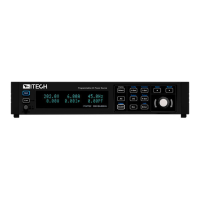Operation and Application
4.6 Turning the Output On and Off
• The [On/Off] key light is off and turning the output off does not
place the instrument in a safe state. Hazardous voltages may be
present on all output and guard terminals. Putting the equipment
into an output-off state does not guarantee that the outputs are
powered off if a hardware or software fault occurs. See the cautions
about connecting the DUT before connecting DUT.
• To prevent electrical shock that could cause injury or death, please
ensure that the power source and DUT have been connected well
before you turn the output on.
• The [On/Off] key is used to turn the output/input on or off under
normal circumstances. Even if the instrument is in control by PC or
the keyboard is locked, the [On/Off] is still valid.
You can turn the IT-M7700 output on or off from the front panel [On/Off] key.
Press the [On/Off] key, and the key lights up, indicating the real-time output is
On. The Meter value on the interface will display the voltage, current, or power
values of the real-time circuit; press [On/Off] key again, and the key lights off,
indicating that the real-time output is Off.
4.7 Step or Continue Output
The voltage value (V-set) and frequency value (F-set) can be output in a step or
continue manner. The following takes the voltage value (Vac / Vdc) from 10V to
20V as an example to illustrate the step and continue change process.
Step Output
1. Press the [V-set] key, turn the knob to set the voltage to 10V, and press
[Enter] to confirm.
2. Press the [On/Off] key to turn on the instrument output.
3. Press the [V-set] button twice in quick succession to enter the Step output
mode (the [V-set] button flashes).
4. Turn the knob to change the output value, and the output waveform value re-
mains constant. After pressing [Enter] to confirm, the output voltage value
will change with the input value. The output waveform is shown in the figure
below.
Copyright © Itech Electronic Co., Ltd.
56

